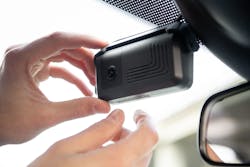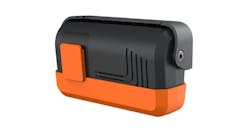Nine tips to help achieve driver buy-in on dash cams
By Eleanor Horowitz, safety product marketing manager, Samsara
Dash cams are some of the most effective devices for improving fleet safety. In fact, the National Surface Transportation Safety Center for Excellence (NSTSCE) found that when combined with driver coaching, dash cams reduced safety-related events by 52%. However, drivers can be skeptical about having a dash cam in their cab for the first time.
While change management can be challenging, it's an important step in adopting dash cams and building a culture of safety within your organization. That’s why I’ve distilled industry best practices and learnings from our most successful customers into nine essential tips for getting driver buy-in.
1. Build trust through transparency
Before deploying any hardware, hold a Q&A session with drivers. Create an open forum where drivers feel comfortable asking questions and raising concerns, and make sure to explain your company’s safety goals and policies so that drivers understand where the change is coming from.
Upfront transparency is key to maintaining driver engagement and minimizing resistance to new technology. In fact, 70% of employees say they’re most engaged when senior leadership communicates openly about changes.
“We’re very transparent when we roll out new equipment about what the process is going to be so our drivers understand where the company is going before we do anything,” said Troy Winthurst, Director of Safety at Dohrn Transfer Company. Winthurst continues to hold a monthly communication meeting with drivers to talk about changes, solicit feedback, and make sure drivers have a direct line to leadership.
2. Explain how the technology works
Dash cams are meant for driver protection and safety. But without knowing how the technology works, drivers may assume an alternate reason: that the cameras are there to watch them.
Dispel misunderstandings by explaining when footage will be uploaded to the cloud. For example, with Samsara, footage is only auto-uploaded when a safety-related event—like harsh braking or turning—is detected. Let drivers know exactly who can access and review footage. In addition, it can help to provide printed collateral and take-home information so drivers know there’s nothing to hide about the technology.
“We told our drivers how the dash cams were going to be used, what triggers a harsh event, and what would happen if there was a harsh event,” said Winthurst. Dohrn also created a private YouTube video to educate their drivers about the new technology and how it would affect their day-to-day.
3. Lead by example and find an internal champion
Show drivers that you’re not afraid of the technology by installing a dash cam in your own vehicle. Then, identify one or two drivers who are well-known across your fleet, and ask them if they would be willing to install dash cams in their cabs. Once they have experienced the dash cams for a few weeks and see how helpful they can be, ask them to share their experiences with other drivers. This will foster a sense of community and make wary drivers feel more at ease.
4. Showcase real exoneration footage
Successfully exonerating drivers is the most powerful way to get skeptical drivers in support of dash cams. If you have an example of a near miss or not-at-fault collision that was captured during a pilot, share the footage with all of your drivers. If you haven’t captured a good example yet, you can use one of the sample clips on Samsara's website.
“Videos have been the biggest tool in getting guys to buy in,” said Alan Drazen, Vice President of Simco
Logistics. Drazen shares footage during quarterly coaching sessions with his entire driving team, which he says is much more effective than mass-produced safety training videos with actors.
5. Be transparent about corrective actions
Make sure to come to an agreement with drivers before deploying your cameras, so there are no surprises once you start coaching. Explain what will trigger verbal or written warnings versus probation or termination. Also clearly define any zero exception behavior, like driving under the influence. Consistent, unbiased enforcement of corrective actions is always important but particularly critical if your drivers are part of a union.
6. Offer incentives and rewards
79% of employees say they work harder when they feel recognized, and 83% say that rewards make them feel more engaged with their job.
Within a few months of deploying your dash cams, introduce a driver safety rewards program. Gamifying driver safety scores and offering rewards (like bonuses, plaques, gift cards, or company-branded gifts) doesn’t just improve driver behavior—it helps drivers feel like they’re benefitting from the dash cams, too.
“Recognizing our very best drivers doesn’t just show our appreciation for them. It motivates all of our drivers to drive safer,” said Robert Howard, COO of Dohrn. After rolling out dash cams, Dohrn introduced a new annual reward for the driver with the highest safety score. The winner will get their name engraved on a wall and receive a commendation that is shared online.
7. Celebrate footage of defensive driving
The NSTSCE has found that a good coaching program “must provide feedback on safe driving behaviors, rather than only risky behaviors, or the process will be viewed negatively.” If dash cams are only ever associated with negative events—like distracted driving or speeding—drivers will learn to dislike them.
Make sure to recognize and reward the moments when dash cams capture footage of drivers responding appropriately, like braking to avoid a collision when they’re cut off. Consider sending a weekly or monthly email to all drivers that highlights footage of excellent driving.
“We want to coach our drivers when they could have done something differently, but we also want to recognize when they do everything right,” said Alex Gustafson, Director of Information Systems at Dohrn. “We make sure to review harsh events where they did nothing wrong, too. Having that feedback loop is what has really helped reduce our harsh events.”
8. Toggle on features in stages
When deploying advanced dash cams with features you can toggle off and on—like in-cab voice coaching—it can be tempting to turn on every feature at once. This can be overwhelming for drivers, causing them to become frustrated with the dash cams before they’ve had the chance to see their benefits. For the first one to two weeks, keep all optional features toggled off. Introducing optional features in stages can result in higher long-term ROI.
This is something that Al Searles, Senior Director of Transportation at Smithfield Foods, learned firsthand. Immediately after installing dual-facing dash cams, they turned on every feature—including voice coaching, which allows the dash cams to play in-cab messages for harsh events, speeding, and unbuckled seat belts.
“We basically put the hardware in the truck and turned everything on,” said Al Searles, Senior Director of Transportation at Smithfield. “What we saw was that the camera would immediately start talking to the driver if he had a harsh event. Those interactions were happening all of a sudden, and it kind of confused the drivers for a couple of days.”
Turning on voice coaching once drivers were more comfortable with the system had a much larger, more positive effect. “We saw a 10-fold drop in harsh events as compared to the first time we turned it on,” said Searles.
9. Consider offering camera covers
Consider offering removable camera covers that drivers can use to block the dash cam lens when needed. Camera covers can make drivers feel more comfortable having a dash cam installed in their cab—especially long-distance drivers who utilize a sleeper berth. Plus, proactively offering a removable camera cover minimizes the chances that a driver will obstruct or permanently damage the hardware.


